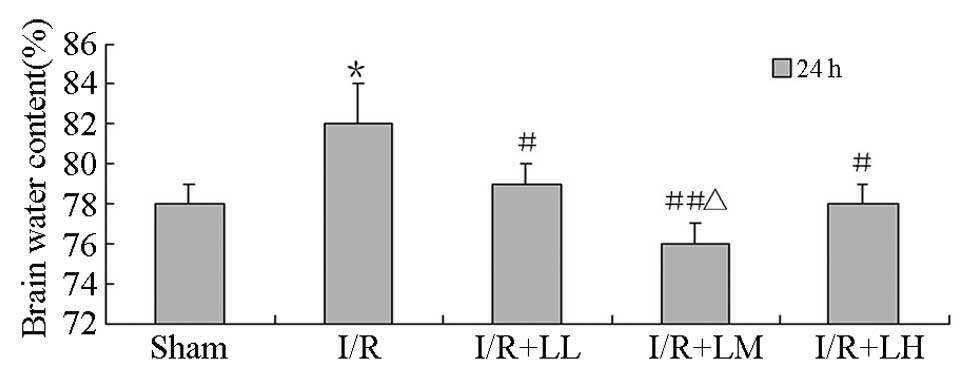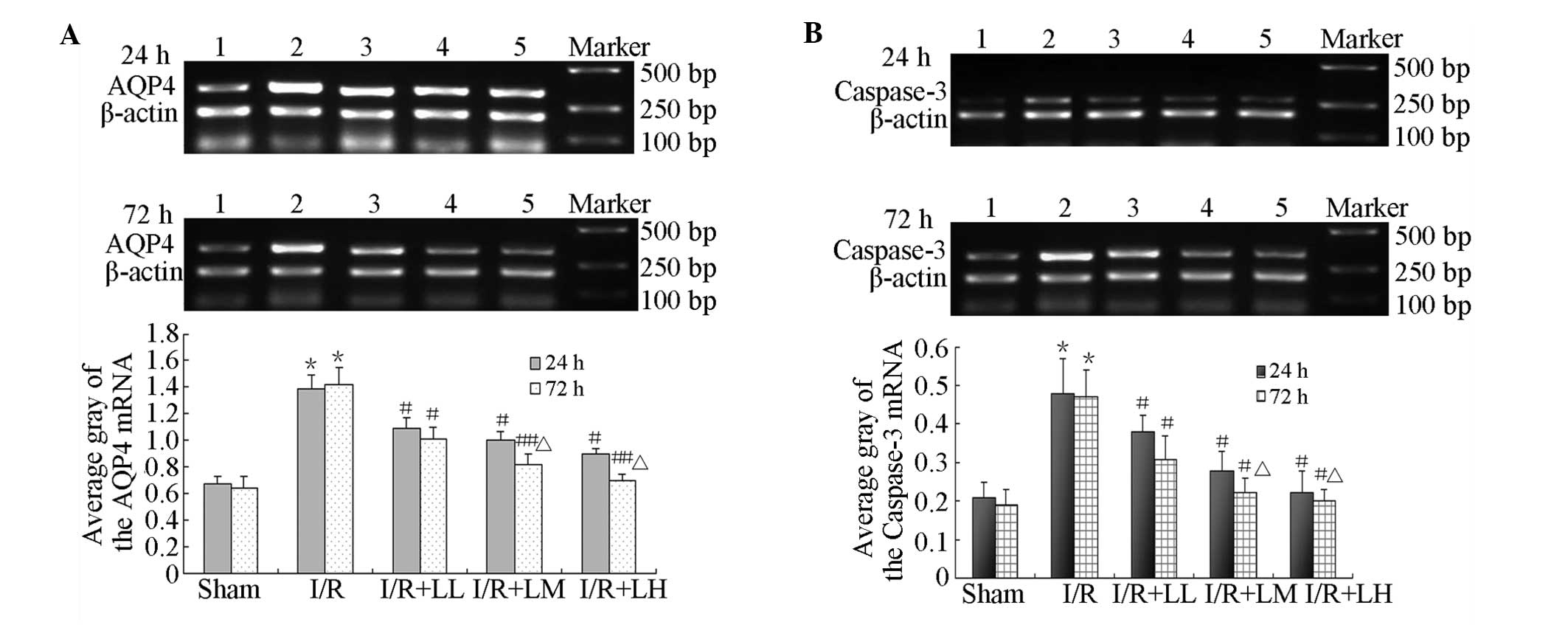|
1
|
Donnan GA, Fisher M, Macleod M and Davis
SM: Stroke. Lancet. 371:1612–1623. 2008. View Article : Google Scholar : PubMed/NCBI
|
|
2
|
Giffard RG and Swanson RA:
Ischemia-induced programmed cell death in astrocytes. Glia.
50:299–306. 2005. View Article : Google Scholar : PubMed/NCBI
|
|
3
|
Ohk TG, Yoo KY, Park SM, et al: Neuronal
damage using fluoro-jade B histofluorescence and gliosis in the
striatum after various durations of transient cerebral ischemia in
gerbils. Neurochem Res. 37:826–834. 2012. View Article : Google Scholar : PubMed/NCBI
|
|
4
|
Li M, Zhang X, Cui L, et al: The
neuroprotection of oxymatrine in cerebral ischemia/reperfusion is
related to nuclear factor erythroid 2-related factor 2
(nrf2)-mediated antioxidant response: role of nrf2 and
hemeoxygenase-1 expression. Biol Pharm Bull. 34:595–601. 2011.
View Article : Google Scholar
|
|
5
|
Taniguchi M, Yamashita T, Kumura E, et al:
Induction of aquaporin-4 water channel mRNA after focal cerebral
ischemia in rat. Brain Res Mol Brain Res. 78:131–137. 2000.
View Article : Google Scholar : PubMed/NCBI
|
|
6
|
Tang Z, Sun X, Huo G, et al: Protective
effects of erythropoietin on astrocytic swelling after
oxygen-glucose deprivation and reoxygenation: mediation through
AQP4 expression and MAPK pathway. Neuropharmacology. 67:8–15. 2013.
View Article : Google Scholar : PubMed/NCBI
|
|
7
|
Gartshore G, Patterson J and Macrae IM:
Influence of ischemia and reperfusion on the course of brain tissue
swelling and blood-brain barrier permeability in a rodent model of
transient focal cerebral ischemia. Exp Neurol. 147:353–360. 1997.
View Article : Google Scholar
|
|
8
|
Simard JM, Kent TA, Chen M, Tarasov KV and
Gerzanich V: Brain oedema in focal ischaemia: molecular
pathophysiology and theoretical implications. Lancet Neurol.
6:258–268. 2007. View Article : Google Scholar : PubMed/NCBI
|
|
9
|
Mori K, Miyazaki M, Iwase H and Maeda M:
Temporal profile of changes in brain tissue extracellular space and
extracellular ion (Na+, K+) concentrations
after cerebral ischemia and the effects of mild cerebral
hypothermia. J Neurotrauma. 19:1261–1270. 2002. View Article : Google Scholar : PubMed/NCBI
|
|
10
|
Spatz M: Past and recent BBB studies with
particular emphasis on changes in ischemic brain edema: dedicated
to the memory of Dr. Igor Klatzo Acta Neurochir Suppl. 106:21–27.
2010. View Article : Google Scholar : PubMed/NCBI
|
|
11
|
Badaut J, Lasbennes F, Magistretti PJ and
Regli L: Aquaporins in brain: distribution, physiology, and
pathophysiology. J Cereb Blood Flow Metab. 22:367–378. 2002.
View Article : Google Scholar : PubMed/NCBI
|
|
12
|
Potterat O: Goji (Lycium barbarum
and L. chinense): Phytochemistry, pharmacology and safety in
the perspective of traditional uses and recent popularity. Planta
Med. 76:7–19. 2010.
|
|
13
|
Prabhakar G, Vona-Davis L, Murray D,
Lakhani P and Murray G: Phosphocreatine restores high-energy
phosphates in ischemic myocardium: Implication for off-pump cardiac
revascularization. J Am Coll Surg. 197:786–791. 2003. View Article : Google Scholar : PubMed/NCBI
|
|
14
|
Broughton BR, Reutens DC and Sobey CG:
Apoptotic mechanisms after cerebral ischemia. Stroke. 40:e331–e339.
2009. View Article : Google Scholar : PubMed/NCBI
|
|
15
|
Li SY, Sun J, Niu BX, Yan FL and Zhan HQ:
Effect of LB on the expression of bcl-2 and bax mRNA and their
protein in rats’ cerebral cortex after cerebral
ischemia-reperfusion injury. Yao Xue Xue Bao. 46:1314–1320.
2011.(In Chinese).
|
|
16
|
Longa EZ, Weinstein PR, Carlson S and
Cummins R: Reversible middle cerebral artery occlusion without
craniectomy in rats. Stroke. 20:84–91. 1989. View Article : Google Scholar : PubMed/NCBI
|
|
17
|
Young W, Rappaport ZH, Chalif DJ and Flamm
ES: Regional brain sodium. potassium and water changes in the rat
middle cerebral artery occlusion of ischemia. Stroke. 18:751–759.
1987. View Article : Google Scholar : PubMed/NCBI
|
|
18
|
Igarashi H, Huber VJ, Tsujita M and Nakada
T: Pretreatment with a novel aquaporin 4 inhibitor, TGN-020,
significantly reduces ischemic cerebral edema. Neurol Sci.
32:113–116. 2011. View Article : Google Scholar : PubMed/NCBI
|
|
19
|
Zeng XN, Xie LL, Liang R, Sun XL, Fan Y
and Hu G: AQP4 knockout aggravates ischemia/reperfusion injury in
mice. CNS Neurosci Ther. 18:388–394. 2012. View Article : Google Scholar : PubMed/NCBI
|
|
20
|
Shin JA, Choi JH, Choi YH and Park EM:
Conserved aquaporin 4 levels associated with reduction of brain
edema are mediated by estrogen in the ischemic brain after
experimental stroke. Biochim Biophys Acta. 1812:1154–1163. 2011.
View Article : Google Scholar : PubMed/NCBI
|
|
21
|
Song DY, Oh KM, Yu HN, et al: Role of
activating transcription factor 3 in ischemic penumbra region
following transient middle cerebral artery occlusion and
reperfusion injury. Neurosci Res. 70:428–434. 2011. View Article : Google Scholar
|
|
22
|
Moroni F: Poly (ADP-ribose) polymerase 1
(PARP-1) and postischemic brain damage. Curr Opin Pharmacol.
8:96–103. 2008. View Article : Google Scholar : PubMed/NCBI
|
|
23
|
Ness JM, Harvey CR, Washington JD, Roth
KA, Carroll SL and Zhang J: Differential activation of c-fos and
caspase-3 in hippocampal neuron subpopulations following neonatal
hypoxia-ischemia. J Neurosci Res. 86:1115–1124. 2008. View Article : Google Scholar : PubMed/NCBI
|
|
24
|
Yip KK, Lo SC, Leung MC, So KF, Tang CY
and Poon DM: The effect of low-energy laser irradiation on
apoptotic factors following experimentally induced transient
cerebral ischemia. Neuroscience. 190:301–306. 2011. View Article : Google Scholar : PubMed/NCBI
|
|
25
|
Xu XH, Zhang SM, Yan WM, et al:
Development of cerebral infarction, apoptotic cell death and
expression of X-chromosome-linked inhibitor of apoptosis protein
following focal cerebral ischemia in rats. Life Sci. 78:704–712.
2006. View Article : Google Scholar
|
|
26
|
Cincioglu M, Kismali G, Ugur SA, et al:
Indinavir inhibits the expression of cytoplasmic aromatase and
nuclear SREBP in the hippocampus of reperfusion injury-induced
ischemic rats. J Steroid Biochem Mol Biol. 130:81–89. 2012.
View Article : Google Scholar : PubMed/NCBI
|
|
27
|
Belayev L, Busto R, Zhao W and Ginsberg
MD: HU-211, a novel noncompetitive N-methyl-D-aspartate antagonist,
improves neurological deficit and reduces infarct volume after
reversible focal cerebral ischemia in the rat. Stroke.
26:2313–2319. 1995.
|












